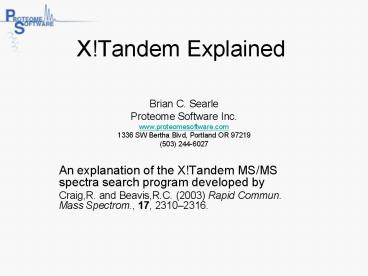X!Tandem Explained PowerPoint PPT Presentation
1 / 18
Title: X!Tandem Explained
1
X!Tandem Explained
- Brian C. Searle
- Proteome Software Inc.
- www.proteomesoftware.com
- 1336 SW Bertha Blvd, Portland OR 97219
- (503) 244-6027
- An explanation of the X!Tandem MS/MS spectra
search program developed by - Craig,R. and Beavis,R.C. (2003) Rapid Commun.
Mass Spectrom., 17, 23102316.
2
X!Tandem Theme
- Central Axiom For each identifiable protein,
there is at least one detectable tryptic peptide.
3
X!Tandem Workflow
X!Tandem, like Mascot and SEQUEST, compares each
spectrum to all likely candidate peptides in a
protein database. One of X!Tandems strengths is
its automatic search for modified peptides but
only on proteins it has otherwise identified. The
following pages explain how X!Tandem matches
peptides, and how this differs from the way
SEQUEST matches them.
Quickly identify proteins from tryptic peptides.
Create database containing identified proteins
only.
Extensively search for modified/ non-enzymatic pep
tides only on identified proteins.
4
X!Tandems Chief Advantage
X!Tandems multi-stage workflow algorithm results
beats a comparable single stage algorithm by a
wide margin.
- Speed
- 200x faster for nonspecific searches
- 1000x faster if you also look for oxidation,
deamidation, and phosphorylation
5
Other X!Tandem Advantages
- Modern search techniques
- Considers semi-tryptic peptides.
- Considers sequence polymorphisms.
- Uses probability-based scoring.
6
Spectra
X!Tandem works by matching the acquired MS/MS
spectra to a model spectrum based on peptides in
a protein database. The model spectrum is very
simple, based on the presence or absence of y and
b ions.
100
acquired spectrum
0
1
model spectrum (y/b ions)
0
7
Spectra matched
Only matching spectral peaks the ones marked in
the figure are considered. Any peaks that dont
match, in either the model or acquired spectra,
are not used.
100
acquired spectrum
0
x
1
hypothetical spectrum (y/b ions)
0
8
Similar peaks
The acquired spectrum is simplified to only those
peaks that are similar to the peaks in the model
spectrum.
100
acquired spectrum
0
100
similar peaks (y/b ions)
0
9
Dot product
X!Tandems preliminary score is a dot product of
the acquired and model spectra. Because only
similar peaks are considered, this is the sum of
the intensities of the matched y and b ions.
predicted? (1,0)
spectrum intensities
100
similar peaks (y/b ions)
0
10
Hyperscore
X!Tandem modifies the preliminary score by
multiplying by N factorial for the number of b
and y ions assigned. The use of factorials is
based on the hypergeometric distribution.
spectrum intensities
predicted? (1,0)
100
similar peaks (y/b ions)
0
11
Histogram of hyperscores
Next, X!Tandem makes a histogram of all the
hyperscores for all the peptides in the database
that might match this spectrum. For example, in
this figure, 52 peptides were found with a
hyperscore of 19, and one peptide with a
hyperscore of 83. X!Tandem assumes that the
peptide with the highest hyperscore is correct,
and all others are incorrect.
incorrect IDs
results
hyperscore
12
Log histogram
If the data on the right side of the histogram,
(colored in upper figure) is taken and
log-transformed, the data fall on a straight
line. A straight line is the expected result from
a statistical argument that assumes the incorrect
results are random. Note this histogram is
calculated independently for each spectrum.
results
hyperscore
log( results)
13
Significant scores
X!Tandem has already assumed that the top
hyperscore is the only possible correct match.
This match is significant if it is greater than
the point at which the straight line through the
log data intersects the log(results)0 line.
Any hyperscores greater than this are unlikely
to have arisen by chance.
results
hyperscore
significant
log( results)
14
E-value
The E-value expresses just how unlikely a greater
hyperscore is. X!Tandem calculates the E-value
by extrapolating the red line of the log
histogram. For the example shown, a hyperscore of
83 would occur by chance where the red line
crosses 83. The log of this value the E-value
is -8.2, as shown.
results
hyperscore
log( results)
E-valuee-8.2
15
X!Tandem vs. SEQUEST
16
Plotting SEQUEST and X!Tandem scores
The sample in this experiment has only 10
proteins. Spectra identifying one of these 10 are
plotted in blue. Spectra in red are incorrect
matches.
X!Tandem and SEQUEST scores for all the spectra
in a control experiment
X!Tandem log(E-value) score
SEQUEST discriminant score (PeptideProphet, ISB)
17
Cutoffs for SEQUEST and X!Tandem
The yellow box contains the spectra with scores
below X!Tandems threshold. The green box shows
the spectra with scores below SEQUESTs
threshold. Note Many good identifications (blue
dots) are below threshold for one, but not both.
X!Tandem log(E-value) score
SEQUEST discriminant score (PeptideProphet, ISB)
18
X!Tandem Summary
- X!Tandem is fast.
- The hyperscore is much faster to calculate than
SEQUESTs XCorr. This allows X!Tandem to build
the histograms that allow it to calculate the
E-values. - X!Tandem grades on a curve.
- Its the E-value that counts, not the
hyperscore. - X!Tandem and SEQUEST can often match different
spectra.

